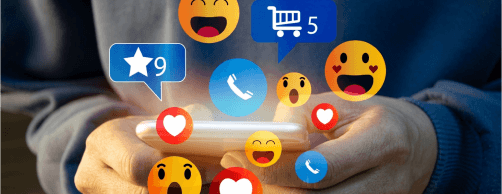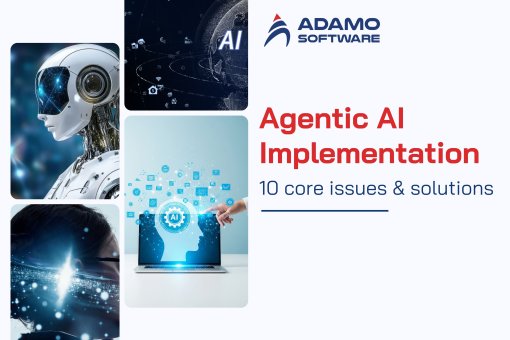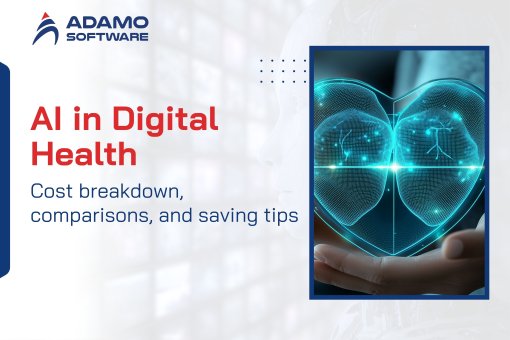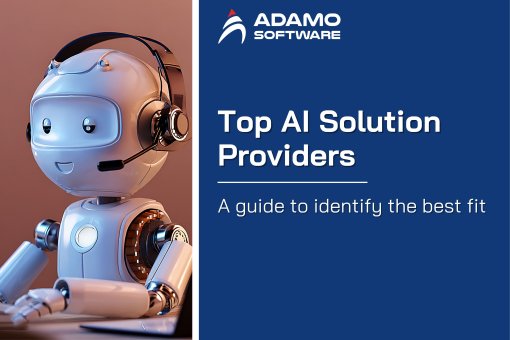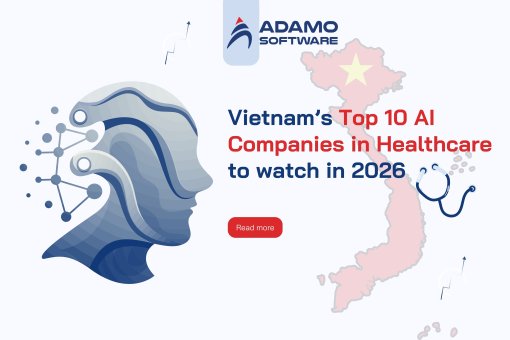NLP in Healthcare: Benefits, challenges and real-world applications
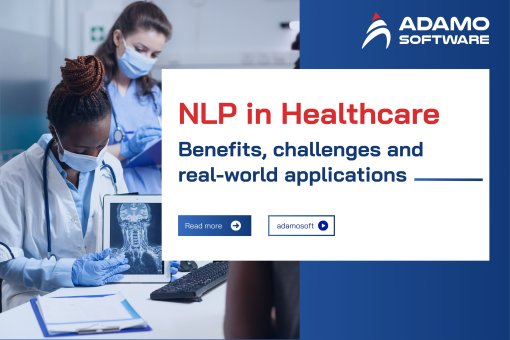
Natural Language Processing in Healthcare makes data smarter. Explore techniques, use cases, and insights that shape the future of digital health.
Natural Language Processing in Healthcare is a discipline that enables computers to read and comprehend human languages in a medical facility. It subjects medical texts, including clinical notes, electronic health records, and reports, to artificial intelligence, machine learning, and text analytics. Using these tools, unstructured language is changed to structured data to aid in the diagnosis, treatment, and monitoring of patients. A typical example is that NLP can smartly derive the data related to symptoms or medications from a doctor’s note, saving time and minimizing the possibility of error.
In 2024, the worldwide Natural Language Processing in Healthcare market reached approximately USD 6.25 billion and is expected to expand with an approximate 34% CAGR over the next few years. This growth indicates the acute necessity of tools that could handle the growing amount of patient data and enhance clinical decision-making.
Recent research points out the opportunities and challenges of this technology. A 2024 study demonstrated a better accuracy of NLP systems developed based on models such as BERT in predicting the outcome of a patient, although the system also highlighted interpretability and the need to be integrated with their current hospital systems. A different review in the Frontiers in Physics called it out that NLP is already aiding in information extraction across imaging and records, which aids in diagnostic support, but practical implementation and ethical considerations are urgent topics.
I. What is Natural Language Processing in Healthcare and how does it work?
Natural Language Processing in Healthcare is a technology that enables computers to interpret, study, and synthesize human language in the medical field. It is a combination of artificial intelligence, machine learning, and computational linguistics to convert unstructured medical text, such as electronic health records, discharge summaries, and physician notes, into structured data that can be used by doctors and hospitals. As an example, it can deduce the diagnosis, medications, or symptoms of a patient based on a clinical note and display these in a form that can be searched. This aids in eliminating human error and assists in making quicker decisions.
Natural Language Processing in Healthcare operates in practice by crunching a lot of text and deriving valuable insights. A 2024 study demonstrated its contribution to such vital activities as clinical documentation, risk prediction, and analysis of patient communication. It is even able to scan through public health statistics and social media and trace outbreaks or reactions to health policies. These operations rely on superior language models, speech recognition, and entity extraction to disclose patterns concealed in unstructured data.
Recent studies also indicate that Clinical Accuracy may be enhanced by Natural Language Processing in Healthcare. In 2024, a review noted its capacity to isolate information in imaging reports and patient records, and this enhances doctoral decision-making. Nevertheless, the same paper cautioned that NLP systems might be difficult to scale, that their applications must be ethical, and that the models would need to be trained uniquely to the healthcare environment.
Altogether, the principle of Natural Language Processing in Healthcare consists of the ability to break down and structure the natural language. It can systematise medical data and deliver insights. And it can be used in clinical practice, research, and patient outcomes.
II. Who needs NLP in Healthcare
NLP in Healthcare is becoming a necessity for several groups, as they all deal with a lot of text and require assistance in making sense of it.
- Providers (doctors, nurses, clinics): for faster, accurate clinical documentation and better care.
- Researchers and trial teams: to speed up and streamline recruitment.
- Researchers and data scientists: to derive insights from text to use in risk and public health.
- Administrators and payers: to automate coding, billing, and administrative processes.
- Policy makers and public health officials: to track health patterns and misinformation.
First, healthcare providers (hospitals, clinics, physicians, etc.) require Natural Language Processing in Healthcare to minimize paperwork. They leverage it to transform their unstructured notes and electronic health records into data that they can take action on in a short time. This conserves time and allows them to work more on patients than on data entry. A 2024 review demonstrates that NLP decreases documentation loads and enhances clinical workflow in telemedicine, allowing the provider to allocate more time to patient care and less time to typing.
Second, Natural Language Processing in Healthcare is required to accelerate the processes of studies by researchers and clinical trial teams. In 2024, researchers stated that NLP can discover trial candidates by automatically scanning electronic health records. This enhances precision in matching and reduces the time of recruitment.
Third, Natural Language Processing in Healthcare allows data scientists and healthcare researchers to unlock insights into unstructured and complex data. In 2024, a narrative review emphasized the role of NLP in risk prediction and the ability to monitor and analyze the health of the population and communicate information, most of which sources are textually bulky.
Fourth, payers and health system administrators should use Natural Language Processing in Healthcare to be efficient. The 2024 market analysis indicates that providers -and, by extension, payers- are major final users of NLP, a tool that facilitates the automation of billing, coding, and other administrative processes.
Lastly, policymakers and public health officials require Natural language processing in healthcare to track trends and identify misinformation. It has been proven that NLP can be used to process large amounts of data. They can be social media or clinical notes. These data will be used to monitor the mood of the population, identify misinformation, or warn of a threat to population health.
Explore Our Tailor-made Software Development Solutions
We are confident in providing end-to-end software development services from fully-functioned prototype to design, MVP development and deployment.
III. 5 main NLP techniques you should know
Some of the techniques are more frequently utilized in Natural Language Processing in Healthcare. They introduce the most value to patients, providers, and researchers. The five most important of them are listed here.
- NER: extracts diseases, drugs, and results.
- Text Classification: sorts of medical notes into useful groups. Sentiment
- Analysis: understands patient emotions.
- OCR: digitizes paper records for analysis.
- Hybrid Approaches: incorporate rules and machine learning to make it more accurate.
1. Named Entity Recognition (NER)
Natural Language Processing in Healthcare applies NER to recognize and annotate important words in clinical text, disease, medication, or test outcomes. This facilitates the process of deriving valuable information from the electronic health record. In a 2024 study, NER could extract clinical conditions and treatment in radiology reports and discharge summaries significantly.
2. Text Classification
Natural Language Processing in Healthcare uses text classification to classify information. In the case of diagnosis, treatment updates, or follow-up instructions, it can classify notes accordingly. This assists hospitals in dealing with large volumes of unstructured data. It was affirmed to be important in organizing electronic health records for predictive analytics.
3. Sentiment Analysis
Sentiment analysis can also be employed through Natural Language Processing in Healthcare to identify how the patients feel in feedback, messages, or even notes. Providers can react with greater empathy as they pick up on tones like anxiety or satisfaction. A 2024 study has emphasized the role of sentiment detection in communication with patients as a predictor of health outcomes and enhanced patient engagement.
4. Optical Character Recognition (OCR)
Natural Language Processing in Healthcare frequently collaborates with OCR to turn scanned documents or hand-written records into digital text. This makes the older medical records that are paper-based searchable and analyzable. According to a review by 2024, interoperability and the loss of valuable historical health data can be reduced through OCR and NLP combined.
5. Rule-based and Hybrid Approaches
Natural Language Processing in Healthcare is often a combination of a rule-based approach (such as medical dictionaries and linguistic patterns) with a statistical or deep learning model. This is a combination method that enhances precision in locating medical concepts. According to a survey conducted in 2024, the integration of rules and machine learning resulted in superior outcomes in the analysis of discharge and admission records.
IV. Benefits and challenges of adopting NLT in healthcare
The use of Natural Language Processing in Healthcare comes with powerful benefits and significant threats. Here’s how they stand.
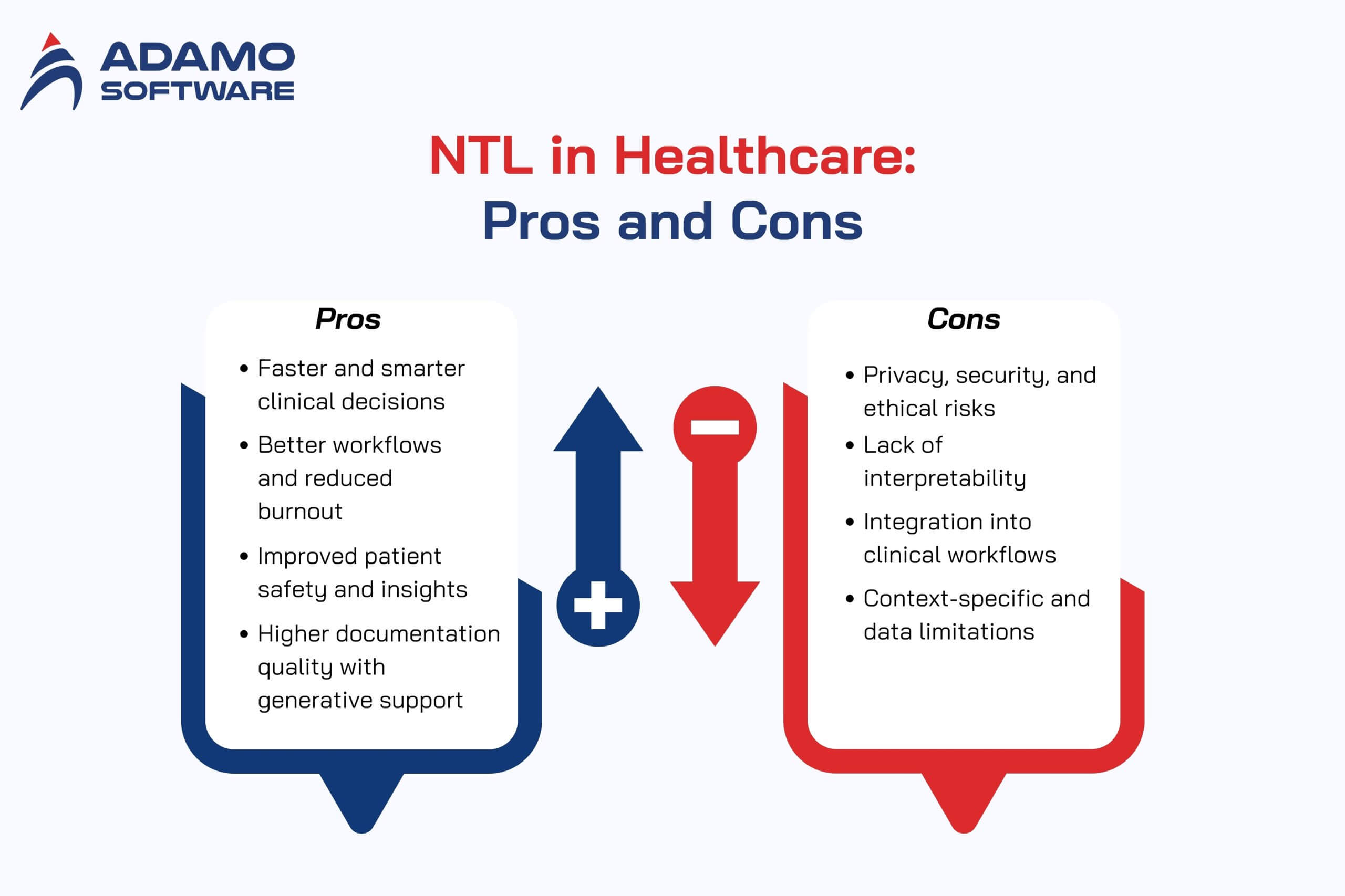
Benefits
1. Faster and Smarter Clinical Decisions
NLP in Healthcare assists in extracting important data when unstructured clinical notes are at hand. A 2024 narrative review demonstrates that NLP enhances the detection of disease at an early stage, improves risk prediction, and promotes improved treatment decisions. It also aids in the analysis of the mood of people and in monitoring patient messages effectively.
2. Better Workflows and Reduced Burnout
The Bots are used in healthcare to automate repetitive work, which involves coding, documentation, and record scanning. This decreases the workload of the frontline personnel. In a 2024 study, NLP accelerates clinical workflows by retrieving structured information in the EMRs and simplifying documentation.
3. Improved Patient Safety and Insight
NLP in Healthcare helps to identify mistakes and errors in information and reduce misleading data or even hallucinating information in medical texts. A scoping review in 2024 confirms that NLP has the potential to detect and correct these problems to improve patient safety.
4. Higher Documentation Quality with Generative Support
Natural Language Processing in Healthcare drives the creation of generative software to write clinical notes (such as SOAP or BIRP notes) by clinical or interactions between clinicians and patients. An example case study published in 2024 demonstrates that such tools can save time, increase the quality of documentation, and decrease clinician burnout.
Ready to Outsource?
Get top-tier IT talent without the hassle. Contact us now!
Challenges
1. Privacy, Security, and Ethical Risks
The field of Natural Language Processing in Healthcare is based on sensitive patient information and when abused, it may lead to privacy breaches. The issue of data leakage, unauthorized access, and biased output is of concern. Open protection and adherence are necessary.
2. Lack of Interpretability
Deep learning models of Natural Language Processing in Healthcare may be opaque black boxes. In a 2024 review, it is highlighted that the interpretability of models is still limited. In the absence of clarity, clinicians would be reluctant to rely on AI decisions.
3. Integration into Clinical Workflows
Natural Language Processing in Healthcare systems can be hard to incorporate into clinical practice. Intuitive systems are unlikely to be adopted and those that cause alert fatigue might lead to lower adoption. Integration is still an ongoing project.
4. Context-Specific and Data Limitations
Natural Language Processing in Healthcare must deal with various types of data and clinical situations. Insufficient domain-specific data and context-adaptive models can restrict the scope of effectiveness in real-world applications.
V. Top 10 use cases of Natural Language Processing in Healthcare
One of the most feasible AI applications in medicine is now Natural Language Processing in Healthcare. It transforms gigantic volumes of free text, such as doctor notes, reports, or patient reviews, into useful information. The ten strongest use cases are listed below.
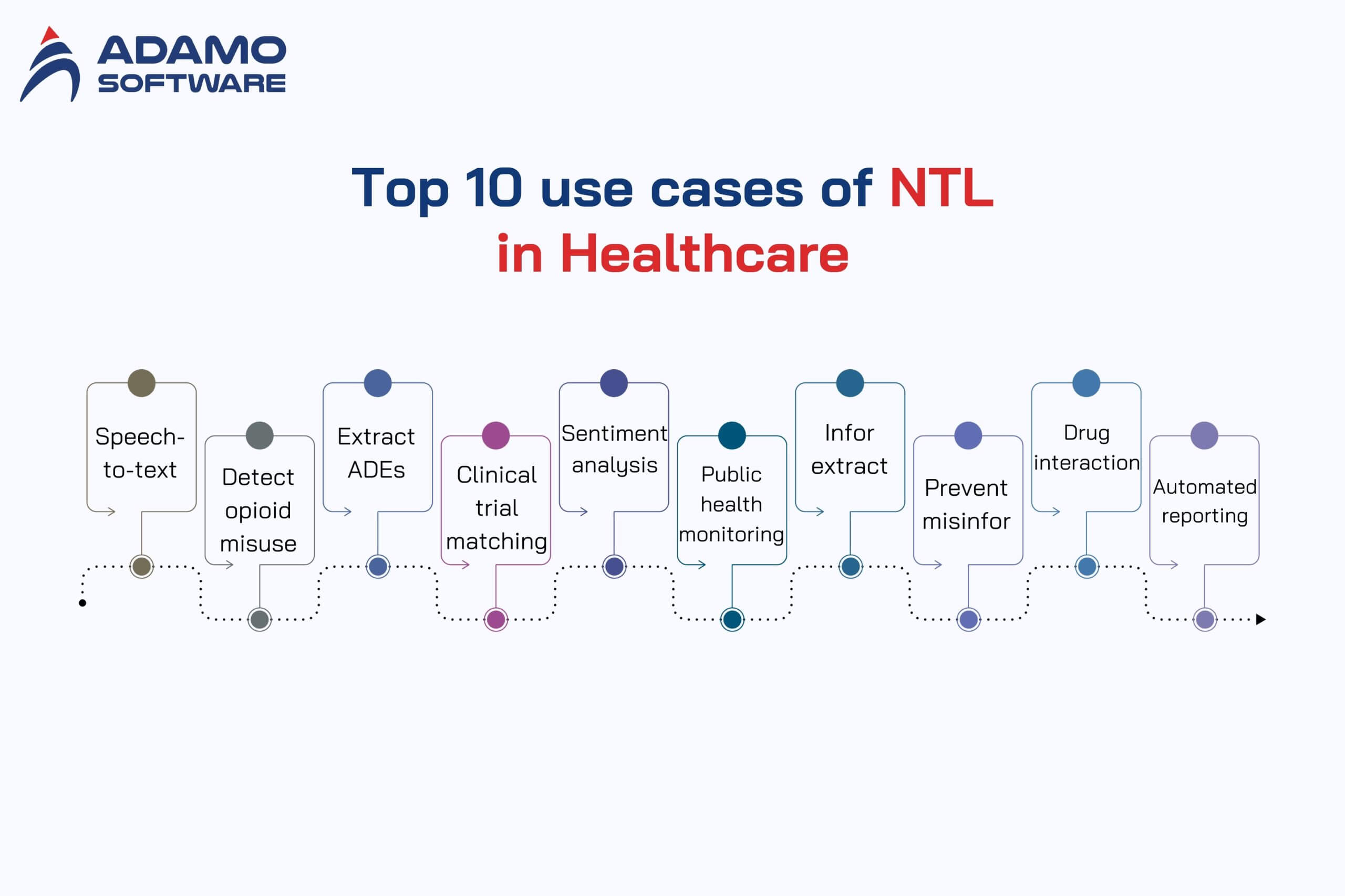
- Speeds up doctor documentation with speech-to-text tools
- Identifies unstructured notes suppressed opioid abuse.
- Extracts adverse drug events for faster drug safety alerts
- Matches patients to clinical trials with higher accuracy
- Evaluates patient feedback to enhance care experiences.
- Tracks diseases and outbreaks from public sources
- Surface clinical information to make decisions.
- Prevents misinformation from AI-generated medical text
- Identifies dangerous drug–drug interactions early
- Auto-reports to the registry on behalf of public health.
1. Speech-to-text clinical documentation
Physicians used to take hours to develop records. Using NLP, they can talk naturally, and the system transcribes, organizes, and summarizes. This minimizes burnout and provides more face-to-face time with patients. In 2024, a large proportion of hospitals in the U.S. that employed AI scribes reported up to 50% faster documentation.
2. Detecting opioid misuse from notes
Numerous problems related to opioids are not represented as coded diagnoses but in text fields. Natural Language Processing in Healthcare can scan clinical notes to identify risky usage, even when those were not entered officially. A 2024 study validated that NLP identified missing patients who were at risk of being missed by only structured data.
3. Extracting adverse drug events (ADEs)
Natural Language Processing in healthcare detects mentions of harmful side effects in records, case reports, or even social media posts. This assists regulators and drug manufacturers in responding on time. There is also a study conducted in 2024 which showed that adverse event reporting with NLP was better in timeliness and completeness than manual reporting.
4. Clinical trial matching
It is expensive and time-consuming to recruit patients in trials. Natural Language Processing in Healthcare goes through unstructured notes to search for the inclusion and exclusion criteria, reducing recruitment time. NLP minimized the screening time in 2024 pilots by up to 70% in cancer research.
5. Sentiment analysis for patient feedback
Surveys, messages, and online reviews are carried out in hospitals. NLP examines the tones and identifies stress, fear, or satisfaction. This assists the personnel in adapting services and communication. A 2024 NLP study emphasized the ability of hospitals to anticipate patient dissatisfaction in advance.
6. Public health monitoring and disease tracking
Natural language processing in healthcare is capable of detecting signs of outbreaks by scanning posts on social media, news, or forums. It facilitates quicker reactions in the flu season or other threats to health in the population. In 2024, Mayo Clinic demonstrated that the systems based on NLP positively affected real-time epidemic awareness.
7. Information extraction from clinical records
Much data—like symptoms, medications, or lab results—is hidden in text. NLP identifies and formats it as decision support, research, or billing. In 2024, a study indicated that NLP was more effective than manual review in the accuracy of chronic disease tracking.
8. Preventing misinformation and hallucinations in AI outputs
AI applications can provide wrong medical facts. These hallucinations are identifiable and can be corrected by Natural Language Processing in Healthcare and making it safe. In 2024 reviews found that NLP and clinical validation should be used to keep AI trusted.
9. Drug–drug interaction detection
Patients are at risk when they use numerous medicines. NLP can also scan notes and literature to identify drug interactions that are hidden. This assists in avoiding hospitalizations of adverse combinations. In 2024, NLP models were improved to achieve higher efficiency in pharmacovigilance in cases of multiple drugs.
10. Automated registry reporting
Cases have to be reported in cancer, birth defects, or rare disease registries to the hospitals. There is time spent manually filling out forms. NLP automates this through scanning of medical records and filling in fields, which saves on resources and guarantees compliance.
Final thoughts

At Adamo, we also understand that Natural language processing in Healthcare is not merely technology but a solution to most of the medical issues in the present day. It allows hospitals to save time on paperwork, provides researchers with deeper knowledge, and assists patients with safer and quicker treatment.
However, we know that algorithms are not the only key to success. It needs good data protection, a proper governance structure, and easy integration into day-to-day medical practice. Under these circumstances, NLP is a formidable ally of physicians and patients.
In the future, Natural Language Processing in Healthcare is going to expand along with AI, precision medicine, and digital medical tools. At Adamo, we take it as our responsibility to add to this change by developing solutions that make healthcare smarter, more human, and more efficient.




